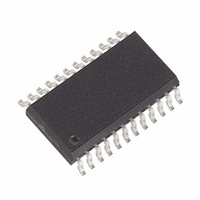MAX4079CWG+ Maxim Integrated Products, MAX4079CWG+ Datasheet - Page 9

MAX4079CWG+
Manufacturer Part Number
MAX4079CWG+
Description
IC A/V BACKEND 24-SOIC
Manufacturer
Maxim Integrated Products
Datasheet
1.MAX4079CWGT.pdf
(15 pages)
Specifications of MAX4079CWG+
Applications
*
Mounting Type
Surface Mount
Package / Case
24-SOIC (7.5mm Width)
Lead Free Status / RoHS Status
Lead free / RoHS Compliant
Figure 1. Differential Audio Inputs
All video inputs are stable with up to 150Ω source resis-
tance. For higher values, consult Maxim applications.
The MAX4079 reconstruction filters are 4th-order
Butterworth filters that provide a cutoff frequency of
6MHz and flat group delay response up to 4.5MHz. The
stopband offers 26dB of attenuation at 13.5MHz and
50dB at 27MHz.
The audio section of the MAX4079 is a stereo amplifier
with one differential input and two single-ended outputs
for each channel (left and right). A mono output is pro-
vided by summing the two channels of the stereo signal
together. The stereo channels have a +6dB typical
gain, while the mono has a +3dB gain.
The audio inputs can be DC-coupled, eliminating space-
consuming coupling capacitors. Each of the five outputs
can deliver 2.6V
The MAX4079 accepts differential audio signals. Figure
1 shows a typical configuration for connecting the
device to an audio DAC with differential outputs. Figure
2 shows the reconstruction filters that can be used for
the differential audio inputs. Carefully select resistors
and capacitors to attenuate out-of-band noise and mini-
AUDIO
+5V
DAC
RMS
Applications Information
A
A
A
A
_______________________________________________________________________________________
OUTR+
OUTR-
OUTL+
OUTL-
into an AC-coupled 10kΩ load.
Video Reconstruction Filter
Audio DAC Interfacing
LINN
RINN
LINP
RINP
Differential Audio DAC
LEFT AUDIO
CHANNEL
RIGHT AUDIO
CHANNEL
MAX4079
Audio
mize the effect on the gain. The common-mode voltage
for these signals is typically 2.5V.
The MAX4079 can also be configured for single-ended
inputs. Figure 3 shows how to connect an audio DAC with
single-ended outputs to the MAX4079. Figure 4 shows
how reconstruction filters can be used for single-ended
audio inputs. Choose these values to minimize the
effect on gain.
If the single-ended audio DAC does not include a com-
mon-mode voltage output, create a bias point with well-
matched resistors and couple the audio signal to the
positive differential input (see Figure 5). The bias point
can also be created using a resistor-divider network
from the video supply voltage. Note that the tolerance of
the resistors will affect the common-mode and power-
supply rejection ratios. Tighter tolerances improve the per-
formance of CMRR and PSRR, e.g., 1% resistors will not
give any better than 40dB of CMRR and PSRR, whereas
0.1% resistors could improve the number to 60dB.
The MAX4079 features single +5V (video) and +12V
(audio) supply operation, and requires no negative
supply. Connect the VVID pins together and bypass to
GVID with 0.01µF, 0.1µF, and 4.7µF capacitors in paral-
lel. Bypass the AUDV to GAUD with 0.1µF, 1µF, and
47µF capacitors in parallel. Bypass CBYPASS to GAUD
with a 1µF capacitor (see the Typical Operating Circuit ).
Figure 2. Filtering Differential Audio Inputs
Complete Audio/Video
A
A
OUTL+
OUTL-
Backend Solution
R1
Power Supplies and Bypassing
R1
C1
R2
R2
C2
C2
Single-Ended Audio DAC
LINN
LINP
MAX4079
9











